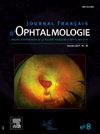Amniotic membrane transplantation in the treatment of macular hole secondary to neuroretinitis
IF 1.2
4区 医学
Q3 OPHTHALMOLOGY
引用次数: 0
Abstract
This case report aims to demonstrate the use of amniotic membrane transplantation (AMT) as a treatment for a refractory full-thickness macular hole (FTMH) that developed secondary to neuroretinitis. A 14-year-old girl presented to our hospital with a complaint of blurred vision persisting for one week. The patient was diagnosed with neuroretinitis due to cat scratch disease with a FTMH that developed secondarily. A pars plana vitrectomy, internal limiting membrane (ILM) peel, and ILM transplantation were performed. The FTMH did not close completely. The third surgery was performed using the AMT method, which resulted in the successful closure of the FTMH. This is the first case report documenting the treatment of refractory FTMH secondary to neuroretinitis using AMT. It can be suggested that inflammation plays a role in the pathophysiology of FTMH secondary to neuroretinitis. We consider AMT to be an effective method in the treatment of resistant FTMH.
Ce cas montre l’utilisation de la transplantation de membrane amniotique (AMT) comme traitement d’un trou maculaire de pleine épaisseur (FTMH) réfractaire développé secondairement à une neurorétinite. Une jeune fille de 14 ans s’est présentée à notre hôpital avec une vision floue persistant depuis une semaine. Le diagnostic était celui de neurorétinite due à la maladie des griffes du chat et à un FTMH qui s’est développé secondairement. Une vitrectomie par la pars plana, un pelage de la membrane limitante interne (ILM) et une transplantation d’ILM ont été réalisés. La FTMH n’a pas complètement fermé. La troisième intervention chirurgicale a été réalisée selon la méthode AMT, ce qui a permis la fermeture du FTMH. Il s’agit du premier cas documentant le traitement par AMT du FTMH réfractaire secondaire à la neurorétinite. On peut suggérer que l’inflammation joue un rôle dans la physiopathologie du FTMH se développant secondairement à la neurorétinite. Nous considérons également que l’AMT est une méthode efficace dans le traitement du FTMH résistant.
羊膜移植治疗继发性神经性视网膜炎黄斑裂孔
本病例报告旨在证明利用羊膜移植(AMT)治疗继发于神经视网膜炎的难治性全层黄斑孔(FTMH)。一名14岁女孩以视力模糊持续一周来我院就诊。患者被诊断为神经视网膜炎,这是由于猫抓病引起的,伴有继发性FTMH。行玻璃体切割、内限定膜剥离、内限定膜移植。FTMH并没有完全关闭。第三次手术采用AMT方法,成功关闭了FTMH。这是第一个用AMT治疗继发于神经视网膜炎的难治性FTMH的病例报告。提示炎症在继发于神经性视网膜炎的FTMH病理生理中起一定作用。我们认为AMT是治疗耐药FTMH的有效方法。我们研究了羊膜移植(AMT)的临床应用,以及如何治疗原发性斑马病(FTMH)、原发性斑马病(FTMH)、原发性斑马病(FTMH)和继发性斑马病(FTMH)。一个年轻人填满了14岁的年龄,他的年龄最大,他的年龄最大,他的年龄最大,他的年龄最大,他的年龄最大,他的年龄最大。诊断性的神经系统疾病-神经系统疾病- 神经系统疾病- 神经系统疾病- 神经系统疾病- 神经系统疾病- 神经系统疾病- 神经系统疾病- 神经系统疾病- 神经系统疾病- 神经系统疾病- 神经系统疾病- 神经系统疾病-1例玻璃体切除术,1例玻璃体切除术,1例玻璃体切除术,1例玻璃体切除术,1例玻璃体切除术,1例玻璃体切除术,1例玻璃体切除术,1例玻璃体切除术,1例玻璃体切除术,1例玻璃体切除术,1例玻璃体切除术,1例玻璃体切除术,1例玻璃体切除术。La FTMH在一份声明中表示:La troisi的干预措施是:将所有的和/或所有的和/或所有的和/或所有的和/或所有的和/或所有的和/或所有的和/或所有的和/或所有的和/或所有的。这是一项主要的文件,文件的主要内容是:神经网络和神经网络和神经网络和神经网络和神经网络和神经网络和神经网络和神经网络和神经网络。在此基础上,研究人员提出了一种新的方法,即通过神经系统的生理病理学分析,将其与神经系统的继发性障碍进行比较。Nous认为,与amt不同的是,它是一种有效的、有效的、有效的、不受FTMH影响的调温器。
本文章由计算机程序翻译,如有差异,请以英文原文为准。
求助全文
约1分钟内获得全文
求助全文
来源期刊
CiteScore
1.10
自引率
8.30%
发文量
317
审稿时长
49 days
期刊介绍:
The Journal français d''ophtalmologie, official publication of the French Society of Ophthalmology, serves the French Speaking Community by publishing excellent research articles, communications of the French Society of Ophthalmology, in-depth reviews, position papers, letters received by the editor and a rich image bank in each issue. The scientific quality is guaranteed through unbiased peer-review, and the journal is member of the Committee of Publication Ethics (COPE). The editors strongly discourage editorial misconduct and in particular if duplicative text from published sources is identified without proper citation, the submission will not be considered for peer review and returned to the authors or immediately rejected.

 求助内容:
求助内容: 应助结果提醒方式:
应助结果提醒方式:


